

Figure 5: The ground floor of the Guildhall, Stratford-upon-Avon, in use as a Library by King Edward VI Grammar School.


The guild of the Holy Cross, Stratford-upon-Avon, was founded in 1269 and dissolved in 1547 (Macdonald 2007; 2012). Throughout the middle ages, the guild was at the centre of Stratford's civic and cultural life, catering for its spiritual needs and fulfilling a range of political and social functions in its buildings, which included guild feasts, manorial court and, from the 1420s, a grammar school. Between 2006-2010 a major programme of historic buildings survey, tree-ring dating and archival research was undertaken by the University of York in collaboration with FAS Heritage, revealing the Guildhall to be one of the best-preserved examples of a late medieval public building in England (Clark and Giles 2006; Giles and Clark 2012). The Grade I-listed complex consists of the Guildhall, a row of adjacent almshouses and the 'Pedagogue's House', occupied by the King Edward VI Grammar School (KES) and the Guild Chapel, maintained by the Stratford Town Trust. Archaeological survey and tree ring dating confirmed that the present guildhall was part of an ambitious programme of rebuilding by the guild from 1417/18 onwards. The two-storey Guildhall parallels examples from other provincial towns, such as York and Boston (Giles 2000; Giles and Clark 2011) (Figures 4-6). The upper floor is likely to have been used for meetings and feasting activities, while the lower floor may have accommodated a series of chaplains' parlours and a small chapel (Giles and Clark 2012, 142-47). The adjacent 'south wing' contained a room referred to in contemporary documents as a 'Countynhows' (Counting House) which functioned as a council chamber for the guild and a further chamber above (Giles and Clark 2012, 147-52) (Figures 7 and 8).


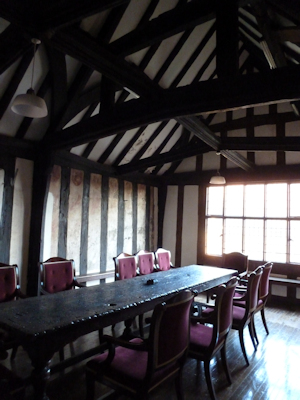
Other buildings in the Guildhall complex include the 'Pedagogue's House', once thought to be the schoolhouse, but now identified as a two-wing hall, parlour and oratory for almsfolk, built in 1502/3 by Thomas Hannys (Arnold et al. 2006; Giles and Clark 2012, 152-54; fig. 9). The date of the almshouses is still uncertain (Figure 10). However, the first building in this range, known as the 'infill house', has recently been identified as the guild's first schoolhouse, dating to c. 1427 (Arnold and Howard 2010; Bearman 2012, 81-2; Giles and Clark 2012, 155). In 1565/6 the school moved out of this building, probably into the first floor of the Guildhall. It was this school that the young William Shakespeare is thought to have attended.
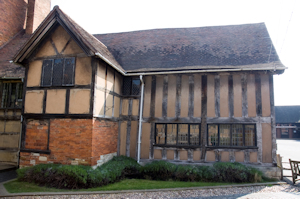
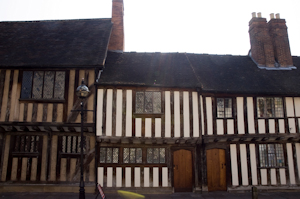
The final building in the medieval guild complex, and one in which the potential of digital creativity has already been demonstrated, is the Guild Chapel (Figures 11-13). This building was extensively rebuilt in the 15th century, by one of the guild's most prominent members, Hugh Clopton (1440-1496), merchant and former Lord Mayor of London 1491/2 (Macdonald 2007, 25). By the end of the 15th century, the chapel contained one of the most interesting examples of a late medieval scheme of wall paintings in England. The chancel contained scenes from the Legend of the Holy Cross, while the Chancel arch featured a Doom, or Last Judgement, painting. On the north wall of the nave was a Dance of Death, opposite scenes from the Life of Adam. At the west end were images of St Thomas à Beckett and St George, together with the Whore of Babylon and a unique memento mori poem. Analysis has revealed the contemporary manuscript sources for this scheme and the ways in which it reflected the devotional and social aspirations of the guild and of Hugh Clopton himself (Davidson 1988; Giles et al. 2012). A groundbreaking digital research tool has been created using VR modelling of the chapel by Giles and colleagues from the University of York (Figure 14). The impact of the work has informed a forthcoming bid to conserve the paintings and open up Stratford's 'best kept secret' to the public.
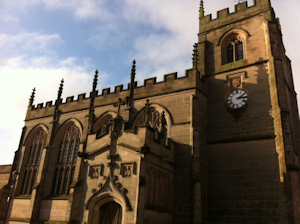
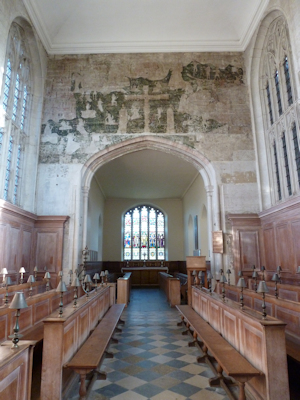
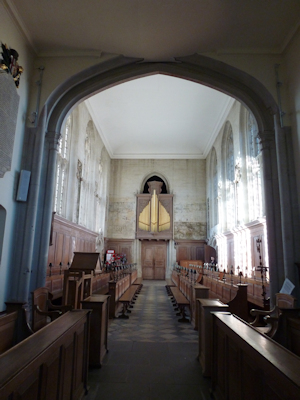
The Guildhall's successful HLF project, 'Willingly to School with Shakespeare' (Figure 15) seeks to re-create the experience of a late 16th-century classroom, enabling the public and scholars from around the world to gain an understanding of the profound importance of a grammar-school education in shaping the young William Shakespeare (Gill 2012b; Green 2012). An important part of Shakespeare's cultural inheritance was the legacy of the later middle ages; the traces of the medieval religious guild who had built the Guildhall and used it until it was taken over by Stratford-upon-Avon's early modern Corporation. Although the English Reformation marked a profound shift in ways of thinking about religion in the 16th century, there was also considerable continuity between these organisations. The guild was dissolved in 1547 but when the Corporation was established in 1553, nine of the 14 men named in the charter had served as proctor, aldermen or master of the Holy Cross guild, while two others were sons or grandsons of former aldermen or masters (Macdonald 2007, 9). The Corporation took over the building, property portfolio and many of the social and charitable activities of the guild (Bearman 1997; 2007; 2012, 106). This was the story in many provincial towns, such as Boston, Coventry, Warwick, Leicester, Walsall, Norwich, Lavenham, Peterborough, Chipping Sodbury and York (Tittler 1991, 160-68; 1998; Giles 2016).

Bearman (2007, 97) has suggested that initially, the Corporation might simply have locked the door of the main Guild Chapel, effectively turning it into a redundant building. This may explain the relatively late references to the destruction of the chapel's scheme of medieval wall paintings in 1563/4, when, as chamberlain, Shakespeare's father John recorded a payment of 2s. for 'defasyng ymages in ye chapell' and in 1564/5, a further 2s for 'takynge doune ye rood loft in ye Chapell' (Savage 1921, 128, 138). Evidence of the Dance of Death may have survived into the 1570s and some traces of the Legend of the Holy Cross still appear to have been visible in 1641 (Giles and Clark 2012, 165-66; Giles et al. 2012, section 2.3). The idea that the young William Shakespeare might have crept into the Guild Chapel to see the ghostly images of corpses dancing with merchants, of shrouded corpses and souls rising from their graves to Judgement, is a compelling one! This is unlikely to have been the fate of the paintings in the Guildhall - a public building open to the scrutiny of Edward VI's commissioners. The survival, concealment or destruction of the religious images in the Guildhall chapel therefore provides a key site within Shakespeare's School where the legacy of the middle ages and the impact of the Reformation can be experienced by the public.
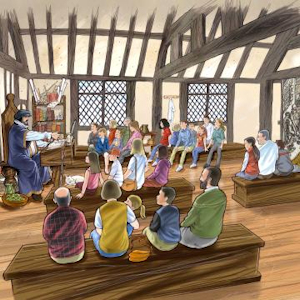
Internet Archaeology is an open access journal based in the Department of Archaeology, University of York. Except where otherwise noted, content from this work may be used under the terms of the Creative Commons Attribution 3.0 (CC BY) Unported licence, which permits unrestricted use, distribution, and reproduction in any medium, provided that attribution to the author(s), the title of the work, the Internet Archaeology journal and the relevant URL/DOI are given.
Terms and Conditions | Legal Statements | Privacy Policy | Cookies Policy | Citing Internet Archaeology
Internet Archaeology content is preserved for the long term with the Archaeology Data Service. Help sustain and support open access publication by donating to our Open Access Archaeology Fund.